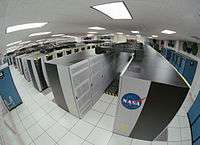NASA Research and Engineering Network

The NASA Research and Engineering Network (NREN) is a nationwide Wide Area Network which connects selected NASA centers and peers with other high-performance network test-beds. It enables NASA scientists, engineers, and researchers to reach their partners within other federal agencies and academia.
The NREN was initially developed in 1996 and has been upgraded several times. It currently has 10 Gigabits-per-second (Gbit/s) connectivity across the continental United States, primarily to link to the Columbia supercomputer at the NASA Ames Research Center in Moffett Field, California.[1]
In March 2006, NREN developed and implemented a custom wireless networking protocol known as Dynamic Source Routing (DSR). DSR was to be used by field teams and robots to facilitate communication in difficult field conditions.[2]
In September 2006 the NREN was used to develop a high transfer rate application called BBFTP to support GOES 5 operations between Ames and Goddard Space Flight Center (GSFC). BBFTP achieved transfer rates as high as 52 Megabytes/sec, and a net transfer of well over 4 terabytes worth of data.[2]
The NREN supported operations of the McGill High Arctic Research Station (MARS).[3]
See also
References
![]() This article incorporates public domain material from the United States Government document "the Research and Engineering Network of the National Aeronautics and Space Administration".
This article incorporates public domain material from the United States Government document "the Research and Engineering Network of the National Aeronautics and Space Administration".
